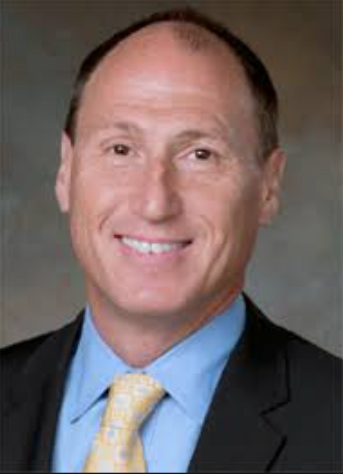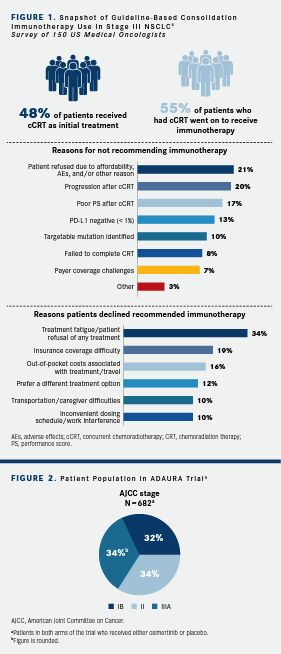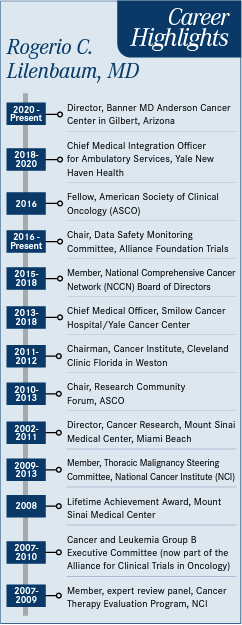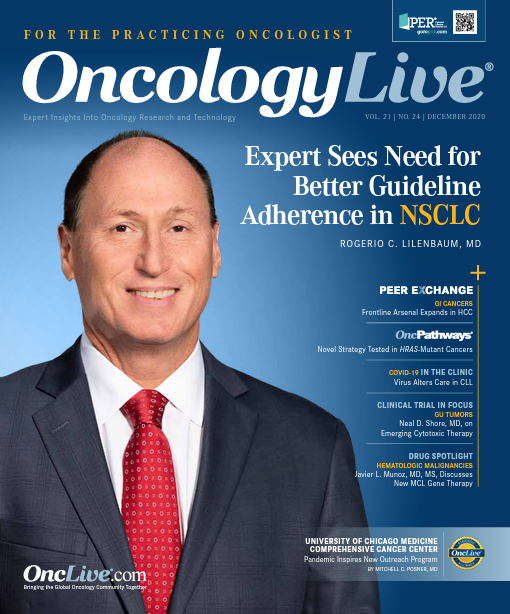Publication
Article
Oncology Live®
Expert Sees Need for Better Guideline Adherence in NSCLC
Author(s):
At the beginning of his career as a medical oncologist in the 1990s, lung cancer specialist Rogerio C. Lilenbaum, MD, was squarely focused on diagnosing and treating his patients while translating emerging clinical research into practice.
Rogerio C. Lilenbaum, MD

At the beginning of his career as a medical oncologist in the 1990s, lung cancer specialist Rogerio C. Lilenbaum, MD, was squarely focused on diagnosing and treating his patients while translating emerging clinical research into practice.
Now, as director and senior physician executive of the Banner MD Anderson Cancer Center, headquartered in Gilbert, Arizona, one of his priorities is fostering a patient-centered experience from an institutional perspective—and his definition of the term is far broader than “this automatic reflex of thinking about welcoming patients or being nice to patients,” which he calls “the minimum expected of everyone in health care.” Instead, he seeks to deliver consistent and timely quality care that encompasses clinical, operational, financial, and cultural considerations.
“It’s the totality of the experience,” Lilenbaum said in an interview with OncologyLive®. Cancer centers, for example, think of access as being “a business opportunity” rather than part of a patient-centered experience, he noted. “If you see patients quickly, they’ll come to you, as opposed to having to wait a week or 2 to go to a better center. That’s how many people, right or wrong, choose where they go [for treatment].
“And yet at the end of the day, it really is unconscionable to keep someone who was just given a diagnosis of cancer waiting weeks to see a physician,” Lilenbaum said. “And that’s a humanistic responsibility. It’s not about market share. It’s the way we all expect to be treated under these circumstances.”
Lilenbaum will bring his real-world blend of patient-centered oncology into focus from February 5 to 7, 2021, at the 18th Annual Winter Lung Cancer Conference®. He is serving as a conference cochair along with Mark A. Socinski, MD, executive medical director of AdventHealth Cancer Institute in Orlando, Florida; and Julie R. Brahmer, MD, MSc, director of the Thoracic Oncology Program and professor of oncology at the Sidney Kimmel Comprehensive Cancer Center at Johns Hopkins in Baltimore, Maryland. The conference, hosted by Physicians’ Education Resource®, LLC (PER®), will be held as a virtual meeting.
The hallmark of the conference, Lilenbaum said, will be the opportunity not only to learn about the most impactful recent trial and study findings but to hear opinions and analysis from leading lung cancer experts. Topics include discussions of when to stop immunotherapy, the role of palliative care in patients with thoracic malignancies, and strategies for treating patients with immunotherapy while molecular testing results are pending.
A special keynote program on addressing critical clinical issues in lung cancer will be held during the opening session on February 5 at 7:55 pm. According to Lilenbaum, one of the most important discussions during that session will center around the optimal use of targeted therapy for patients with non–small cell lung cancer (NSCLC).
Lilenbaum’s concerns involve the uptake of biomarker testing. Although molecular testing is recommended for all patients with advanced nonsquamous NSCLC and certain populations with squamous cell disease, rates of adoption vary depending on the aberration in the United States and in other countries. Whereas testing for EGFR mutations and ALK translocations has reached as high as 87% and 69%, respectively, in some US areas, testing for ROS1 alterations was only at 28% in one study.1
“Are we testing everyone for all the actionable mutations? And are we treating those patients according to evidence-based algorithms and guidelines?” Lilenbaum asked. “This may seem a very obvious thing to do, but it’s far from common practice. Testing, in this day and age, still is somewhat erratic. It’s not pervasive or as generalized as it should be. And then even within each category—EGFR, ALK, ROS1, RET, BRAF V600E—the information about how to best manage those patients is not always within the domain of the general oncologist.”
The introduction of immune checkpoint inhibitors (ICIs) into the treatment paradigm has further complicated therapeutic strategies, illustrating the need for a greater understanding of which patients would most benefit from ICIs, Lilenbaum continued.
Heather A. Wakelee, MD, a professor of medicine and faculty director of the Stanford Cancer Clinical Trials office at Stanford University Medical Center in California and president elect of the International Association for the Study of Lung Cancer, agreed with the need to improve patient selection approaches.“
It is critical to wait for full information about a newly diagnosed lung cancer before starting a patient on treatment,” said Wakelee, who will serve as a cochair of the 22nd Annual International Lung Cancer Congress® in July 2021. “PD-L1 results come back very quickly, and the molecular results for EGFR, ALK, ROS1, and BRAF [alterations] and so on can take several weeks. Patients with molecular driver mutations like EGFR and ALK are much better treated with targeted therapy and do poorly on immunotherapy. If immunotherapy is started too quickly, it can complicate use of targeted therapy because of increased toxicity risks. So it is much better to wait for full information so a patient can be started on the best therapy instead of rushing to start immunotherapy when only some information [on PD-L1] is back.”
It would be a significant step forward to have additional biomarkers beyond PD-L1 expression levels for recommending patients with NSCLC for ICI therapy, Lilenbaum stated. “The question is, how do we identify patients who truly benefit from checkpoint inhibitors beyond just the PD-L1 marker?” he asked. “We’ve seen now, years into this research, that in some patients, the benefit is nothing short of extraordinary. And in other patients, it’s fairly modest. Yes, PD-L1 is a marker that can help ascertain that magnitude of benefit, but it’s far from perfect. I think we need additional predictive factors to justify the cost and the toxicity of these agents.”
Early-Stage Immunotherapy
At the same time, Lilenbaum said, the PD-L1 inhibitor durvalumab (Imfinzi) appears to be underused in the consolidation setting, a problem he called “baffling.” In February 2018, the FDA approved durvalumab for patients with unresectable stage III NSCLC whose disease has not progressed following concurrent platinum-based chemoradiation therapy (cCRT).2
The decision, which represented a new standard in this disease setting, was based on findings from the phase 3 PACIFIC trial (NCT02125461) in which 713 patients in this population who had received at least 2 cycles of cCRT were randomized 2:1 to receive durvalumab or placebo. At a prespecified interim analysis, median overall survival (OS) was not reached (NR) among participants treated with durvalumab (95% CI, 34.7 months-NR) compared with 28.7 months (95% CI, 22.9-NR) for those who received placebo, translating into a hazard ratio favoring durvalumab of 0.68 (95% CI, 0.53-0.87; P = .0025). Median progression-free survival was 16.8 months (95% CI, 13.0-18.10) with durvalumab versus 5.5 months (95% CI, 4.6-7.8) with placebo (HR, 0.52; 95% CI, 0.420.65; P < .0001).2
In updated findings reported after a median follow-up of 33.3 months, the median OS with durvalumab was still NR (95% CI, 38.4-NR) versus 29.1 months (95% CI, 22.1-35.1) with placebo (stratified HR, 0.69; 95% CI, 0.55-0.86). The OS rates with durvalumab compared with placebo, respectively, were 83.1% versus 74.6% at 12 months, 66.3% versus 55.3% at 24 months, and 57.0% versus 43.5% at 36 months.3
“We have unequivocal data that 1 checkpoint inhibitor, durvalumab, improves outcomes” for patients with stage III unresectable disease, Lilenbaum said. “And yet, to the best of my knowledge, the utilization of that strategy is not as high as it should be.”
The management of therapeutic choices for this patient population is complex, Lilenbaum acknowledged. “In order to get to the durvalumab piece, [the patient] has to have received concomitant chemotherapy and radiation and not everybody does.” Nevertheless, he said, “it surprises me at times that powerful data like these are still not applied more widely.”
Findings from a recent survey reflect Lilenbaum’s concerns. The percentage of patients with unresectable stage III NSCLC who received guideline-recommended cCRT as initial therapy was an average of 48% and, of those, only 55% subsequently received immunotherapy, according to responses from 150 US medical oncologists published in October 2020 in JCO Oncology Practice (Figure 1).4

Adjuvant Therapy Breakthrough
Looking forward, Lilenbaum anticipates that molecularly targeted therapies as well as immunotherapies will be used earlier in the NSCLC treatment timeline. Recent clinical data for osimertinib (Tagrisso) in patients with completely resected EGFR-positive stage earlier-stage disease represent “a breakthrough that will change the way we do adjuvant treatment,” Lilenbaum said.
In the phase 3 ADAURA trial (NCT02511106), 682 patients with stage II to IIIA disease were randomized 1:1 to receive osimertinib or placebo (Figure 2). At 24 months, 89% of participants treated with osimertinib (95% CI, 85%-92%) were alive and disease-free versus 52% of those who received a placebo (95% CI, 46%-58%), which translated to an overall hazard ratio for disease recurrence or death for osimertinib therapy of 0.20 (99.12% CI, 0.14-0.30; P < .001).5

The FDA has granted a priority review for a supplemental new drug application for osimertinib as adjuvant treatment for patients with early-stage EGFR-mutant NSCLC after complete tumor resection. A decision is expected during the first quarter of 2021, according to AstraZeneca, the company developing the drug.6
“I think we’re going to see similar data for other molecular alterations,” Lilenbaum said. “And more importantly, we will see data for immunotherapy in the early-stage settings. How you apply the knowledge that we’ve acquired in late-stage disease to early-stage disease is one of the most potentially impactful areas of research because in early stage, what you’re doing is beyond prolonging life, you’re increasing the cure rate. And that’s what we want to see.”
Broader Role in Cancer Care
Throughout his career in the lung cancer field, Lilenbaum has often focused on helping to define best practices and optimal treatment choices. He has participated in crafting National Comprehensive Cancer Network guidelines for NSCLC and malignant pleural mesothelioma as well as American College of Chest Physician recommendations for the use of chemotherapy in patients with stage IV NSCLC.
“I believe in the power of guidelines,” Lilenbaum said, adding that such recommendations should be routinely used in clinical practice. Beyond that, guidelines are incorporated into clinical pathways that are integrated into electronic medical records. “Clinical pathways address, to some extent, heterogeneity in how people choose to treat certain diseases, and bring some measure of consistency in how a certain practice decides to treat a group of patients.”
Lilenbaum’s path to his administrative role at Banner MD Anderson spans 2 continents. His early years were spent in his native Brazil. After earning his medical degree from the Federal University of the State of Rio de Janeiro School of Medicine and Surgery and starting his training in the late 1980s, he realized he wanted to become a medical oncologist. He came to the United States in the mid 1990s to pursue opportunities in cancer care.
“I enjoyed not only the practice of medicine in the United States, but also the academic component, specifically the opportunity to be involved in clinical research,” Lilenbaum said. “By the time I was finishing my fellowship, I really couldn’t see myself in any other place. And I was very fortunate to have outstanding mentors who opened a lot of doors and opportunities for me. So I had an early entry into the world of lung cancer investigation and research.”
The attraction to oncology at that point was the development of chemotherapy drugs that offered promise for the treatment of patients with NSCLC. “This was a disease that up until the early to mid ’90s had essentially 1 or 2 regimens that had shown some efficacy, and by the way, horrendous toxicity as well,” Lilenbaum noted. “The new drugs at the time seemed to provide greater benefit, and lower toxicities.”
At the outset of his career, Lilenbaum spent 80% or more of his time seeing patients. After approximately 15 years of an active clinical practice, however, he decided he wanted to find ways to influence how treatment is delivered in broader terms, and then take that experience into organizations that were creating a comprehensive, integrated cancer care delivery system.
“In many ways, it’s more challenging than clinical care or clinical research, but no less important,” said Lilenbaum, who now sees patients less than 10% of the time. Part of the challenge is learning the skills needed to be an administrator.“
Certainly, physicians in my generation were not trained for this,” Lilenbaum said. “We don’t necessarily graduate from a fellow-ship with organization skills or leadership skills. If anything, we’re trained to acquire a certain body of knowledge and make decisions independently on behalf of the individual in front of you who happens to be a patient at the time.”
Lilenbaum’s opportunity to translate his knowledge in a more foundational way came when he was recruited to be chief medical officer for the Yale Cancer Center and Smilow Cancer Hospital at Yale New Haven Health in Connecticut, where he oversaw clinical programs and clinical operations, as well as quality, safety, and network development for the cancer program. Working with some of the country’s top practitioners in cancer care propelled him forward.
In February 2020, Lilenbaum began his new role as director and senior physician executive of a group of facilities at Banner MD Anderson Cancer Center,7 where instilling the patient-centered experience throughout the organization is one of his main goals. “People need comfort, support, guidance, because they are overwhelmed by what’s going on with them,” he said.
To illustrate his point, Lilenbaum related an anecdote from a colleague at another center who was able to obtain VIP treatment for her elderly father when he was diagnosed with cancer. Her father saw multiple doctors and received an infusion on the same day. The visit overall was exhausting but appeared to be a complete success; the marathon day wrapped up around 7 pm.
“But when they left the facility, the valet guy was no longer there,” Lilenbaum recalled. “And they could not find the keys to their car. They spent another 45 minutes trying to find the keys. That particular moment, in a way, tainted their entire experience of what until then had been an excellent day.”
The challenge at Banner MD Anderson is fully integrated treatment across about 10 facilities in Arizona and Colorado. In short, regardless of where patients are treated, they should receive the same level of treatment and have a similar experience.
“Different allocation of resources is expected. For example, you’re not going to have a bone marrow program in every one of your facilities,” Lilenbaum said. “But basic services need to be widely available. To create that alignment, to create that sense that it’s all one experience, is a pretty challenging goal from an administrative and financial perspective.”
Coping With COVID-19
Like all cancer centers in America, Banner Health has been forced to meet the challenge of how to maintain care in the face of coronavirus disease 2019 (COVID-19). Banner’s Arizona facilities were put to the test, treating approximately 45% of all patients with COVID-19 in the state, Lilenbaum pointed out. By taking numerous preventive measures, they were able to keep the cancer center campus 100% free of the virus.
“That was a spectacular win for our patients and our staff,” Lilenbaum said. “Patients who came in and were found to have COVID-19 were transferred to other facilities, and we would take other patients from those facilities to make sure that we were all managing the bed utilization appropriately. But we did not want to have patients with COVID-19 on this campus [in Gilbert, Arizona] because this is where we have our most vulnerable, at-risk patients.”
“We also started to test our patients early on before certain types of cancer intervention,” he explained. “So we knew that if they were to be subjected to interventions that might diminish their resistance or increase their vulnerability to the virus, we would at least know that they were negative ahead of time. Then we started to test high-risk staff members, so that we knew that they could interact with those patients.”
Banner MD Anderson was also included in the first wave of telehealth use, he noted, allowing staff to become comfortable with the process from the outset and enabling them to treat patients with cancer without bringing them on campus unnecessarily. Lilenbaum predicted that insurance companies might tighten up on reimbursements for telehealth, but now that the technology has been put to use, there is no turning back.
“I don’t know that we will have as much freedom and flexibility as we had during the peak of the pandemic, but I think everybody realizes that this is a technology that is here to stay,” he said.
References
1. Pennell NA, Arcila ME, Gandara DR, West H. Biomarker testing for patients with advanced non–small cell lung cancer: real-world issues and tough choices. Am Soc Clin Oncol Educ Book. 2019;39:531-542. doi:10.1200/EDBK_237863
2. Imfinzi. Prescribing information. AstraZeneca; 2020. Accessed November 29, 2020. https://bit.ly/2VeBGO7
3. Gray JE, Villegas A, Daniel D, et al. Three-year overall survival with durvalumab after chemoradiotherapy in stage III NSCLC–update from PACIFIC. J Thorac Oncol. 2020;15(2):288-293. doi:10.1016/j.jtho.2019.10.002
4. Cotarla I, Boron ML, Cullen SL, et al. Treatment decision drivers in stage III non-small-cell lung cancer: outcomes of a web-based survey of oncologists in the United States. JCO Oncol Pract. 2020;16(10):e1232-e1242. doi:10.1200/JOP.19.00781
5. Wu YL, Tsuboi M, He J, et al; ADAURA Investigators. Osimertinib in resected EGFR-mutated non–small-cell lung cancer. N Engl J Med. 2020;383(18):1711-1723. doi:10.1056/NEJMoa2027071
6. Tagrisso granted priority review in the US for the adjuvant treatment of patients with early-stage EGFR-mutated lung cancer. News release. Business Wire. October 20, 2020. Accessed November 29, 2020. https://bwnews.pr/3ljCAmZ
7. Banner MD Anderson names new director. News release. Banner Health. December 23, 2019. Accessed November 29, 2020. https://bit.ly/3loDy1c


























%20(2)%201-Recovered-Recovered-Recovered-Recovered-Recovered-Recovered-Recovered-Recovered-Recovered-Recovered-Recovered-Recovered-Recovered-Recovered-Recovered-Recovered-Recovered.jpg?fit=crop&auto=format)
%20(2)%201-Recovered-Recovered-Recovered-Recovered-Recovered-Recovered-Recovered-Recovered-Recovered-Recovered-Recovered-Recovered-Recovered-Recovered-Recovered-Recovered-Recovered.jpg?fit=crop&auto=format)
